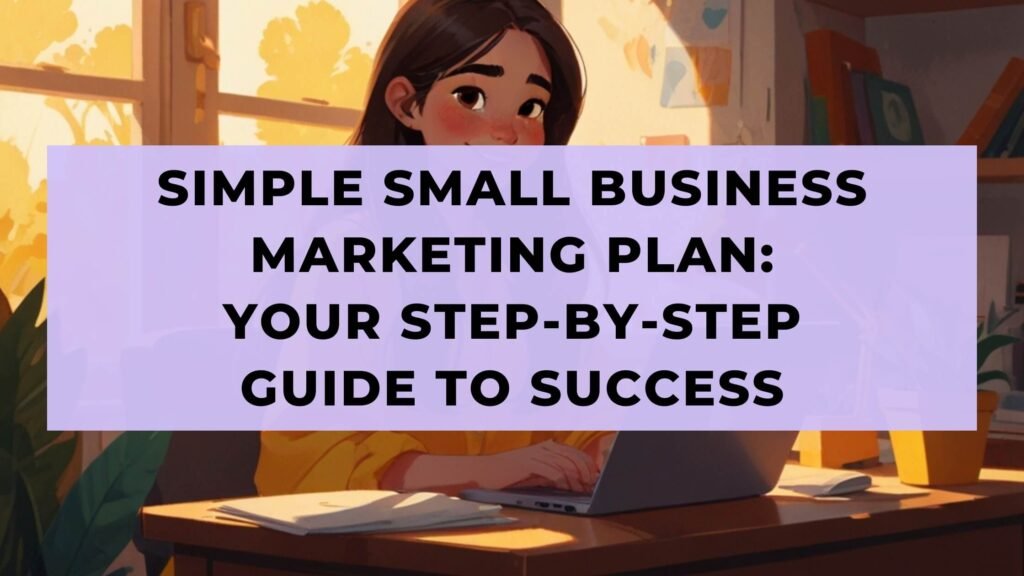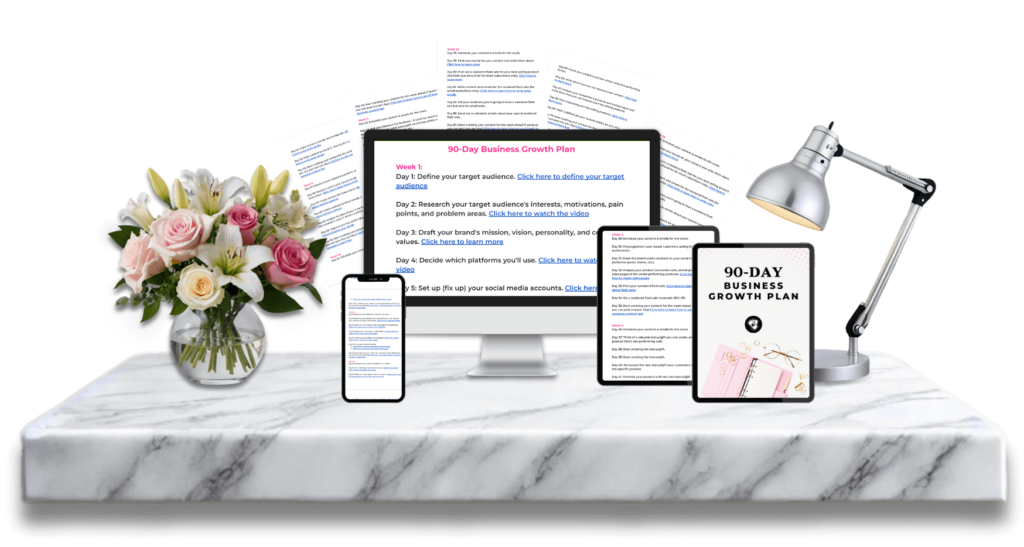So, you’ve started your small business, or maybe you’ve been running it for a while, and things are going okay. But deep down, you know there’s more potential.
You want to reach more people, sell more digital products, and just grow your business. That’s where a marketing plan comes in. It’s like having a roadmap that tells you exactly where to go and what to do to get there.
But don’t worry, creating a marketing plan doesn’t have to be complicated. In this guide, we’re going to break it all down into simple steps. You’ll learn how to figure out who your customers are, where to find them, and how to get them interested in what you’re selling.
By the end of this blog, you’ll have a solid small business marketing plan that’s ready to roll!

This post includes affiliate links to products I love and recommend, meaning I may receive a small commission at no extra cost to you. Please read full disclosure for more information.
Do you feel stuck in business, even though you’re always busy?
Imagine – instead of burning yourself out, you get to focus on ONE ESSENTIAL thing each day that will help you grow your business and boost your sales.
Grab my 90-Day Business Growth Plan and overcome the business stagnation

What is a Small Business Marketing Plan?
First things first – what exactly is a marketing plan? A small business marketing plan is a detailed guide that outlines your business’s marketing goals, strategies, and actions. It’s a way to organize your efforts and make sure you’re using your time and money wisely.
Think of it like this: if your business is a car, your marketing plan is the GPS. It helps you find the fastest route to success, avoid detours, and reach your destination smoothly.
Why is a Marketing Plan Important for Small Businesses?
You might be thinking, “Do I really need a marketing plan? Can’t I just wing it?” While it’s tempting to jump right into action, having a plan can make a huge difference. Here’s why:
- Focus: A small business marketing plan helps you stay focused on your goals. Instead of trying a bunch of random things, you’ll have a clear strategy to follow.
- Budget: With a plan, you can allocate your budget more effectively. You’ll know what to spend your money on and what to skip.
- Measure Success: A good marketing plan includes ways to measure your success. This means you can see what’s working and what’s not, so you can adjust as needed.

Step 1: Understand Your Market
Before you start promoting your business, you need to know who you’re promoting it to. This step is all about understanding your market – who your customers are, what they want, and where they hang out.
Who Are Your Customers?
Start by figuring out who your ideal customers are. Ask yourself questions like:
- How old are they?
- What are their interests?
- What problems do they have that your business can solve?
- What do they want to achieve?
This helps you create a “customer persona,” which is like a detailed profile of your typical customer. For example, if you have a weight loss business, your customer persona might be a 30-year-old first-time mom who wants to lose baby weight and is willing to spend money on postpartum weight loss e-books.
Where Are Your Customers?
Once you know who your customers are, you need to find out where they spend their time. Do they hang out on social media? If so, which platforms? Do they read certain blogs or magazines? Understanding where your customers are will help you know where to focus your marketing efforts.

Step 2: Set Clear Marketing Goals
Now that you know who your customers are, it’s time to set some goals. What do you want to achieve with your marketing? Maybe you want to increase your website traffic with Pinterest, get more followers on Instagram, or boost your sales through social media.
SMART Goals
One popular way to set goals is by using the SMART method. SMART stands for:
- Specific: Be clear about what you want to achieve.
- Measurable: Make sure you can track your progress.
- Attainable: Set goals that are realistic.
- Relevant: Your goals should align with your business’s overall objectives.
- Timely: Give yourself a deadline to achieve your goals.
For example, instead of saying, “I want more sales,” a SMART goal would be, “I want to increase sales by 20% in the next three months by running targeted Facebook ads.” This goal is specific, measurable, achievable, relevant, and time-bound.
By setting clear goals, you’ll have a better idea of what success looks like for your business and can track your progress as you go.

Step 3: Analyze Your Competition
To stand out in your market, it’s important to know what your competitors are up to. This doesn’t mean copying them, but rather understanding what works for them and finding ways to do it even better.
Who Are Your Competitors?
Start by identifying your main competitors. These could be businesses that sell similar digital products or those that target the same audience as you. Once you know who they are, take a closer look at their marketing efforts:
- What digital products or services do they offer?
- How do they price their digital products?
- What kind of content are they sharing on social media?
- How do they engage with their customers?
By analyzing your competitors, you can find gaps in the market – areas where you can offer something different or better. Maybe they’re not addressing a certain need that you can fulfill, or perhaps they’re not using a particular marketing channel that you could take advantage of.
Step 4: Choose Your Marketing Channels
Now that you clearly understand your market, goals, and competition, it’s time to decide where to focus your marketing efforts. With so many options out there, it’s easy to feel overwhelmed. But don’t worry – you don’t have to be everywhere at once. It’s better to start with a few key platforms and do them well.

Social Media
Social media is a powerful tool for small businesses. It allows you to connect with your audience, showcase your products, and build a community around your brand. But with so many platforms out there, how do you choose the right ones?
- Instagram: Great for visual content like photos, videos, and stories. Perfect if you have a visually appealing product.
- Facebook: Offers a wide range of tools, including groups, ads, and a marketplace. Good for building a community and running targeted ads.
- Pinterest: Ideal for businesses with highly visual content and blog posts. Pinterest users often search for ideas and inspiration, making it a great place to share your products and attract potential customers. Pinterest is amazing for growing your business – it’s my favorite platform that drives me thousands of visitors per month. You’re probably one of them 😉
When choosing your social media platforms, think about where your audience spends their time and what kind of content they enjoy. If your audience loves watching tutorials, you might focus on Instagram or Facebook marketing where you can post videos and go live.
You should also create a Social Media Marketing Plan For Your Small Business, so you’ll easily grow your platform.
Email Marketing
Don’t underestimate the power of a good email list. Email marketing allows you to reach your audience directly in their inbox, which is a more personal space than social media. Plus, people on your email list have already shown interest in your business, making them more likely to convert into paying customers.
Start by building an email list through your website or social media channels. Offer something valuable in exchange for their email. You can find 81 lead magnet ideas here. Then, use email marketing to keep them engaged with regular updates, tips, and special offers.

Content Marketing
Content is king, as they say. Creating valuable, informative content can help you attract and retain customers. This could be in the form of blog posts, videos, social media posts, or even podcasts. The key is to provide content that your audience finds useful and engaging.
For example, if you sell digital products, you could create blog posts that offer tips and advice on how to use them effectively. Or, if you’re active on Instagram, you could share behind-the-scenes videos that show how to use your products.
You might want to read my other blog post: Keys to Success with Social Media Content Marketing
Step 5: Create Your Marketing Content
Now that you’ve chosen your marketing channels, it’s time to start creating content. Your content should align with your goals and speak directly to your audience.
Types of Content
- Blog Posts: Great for SEO and providing valuable information to your audience.
- Social Media Posts: Quick, engaging content that keeps your audience connected with your brand.
- Email Newsletters: Regular updates that keep your subscribers informed and engaged.
- Videos: Perfect for showcasing your products, tutorials, or behind-the-scenes looks at your business.
When creating content, always keep your audience in mind. What are their needs and interests? How can your content help solve their problems or improve their lives? The more you can connect with your audience on a personal level, the more successful your marketing efforts will be.

You’ll also love to read: Top 7 Types Of Social Media Content You Need In Business
Content Calendar
To stay organized and consistent, consider creating a content calendar. This is a schedule that outlines what content you’ll post, when, and on which channels. A content calendar helps you plan ahead, ensuring that you’re always prepared with fresh content. It also helps you see the big picture, making it easier to align your content with your marketing goals.
- You can get my Social Media Content Planner (template) here
- And a huge bundle of 7+ Years of Social Media Content Ideas here

Step 6: Monitor and Adjust Your Plan
Once your marketing plan is in action, it’s important to monitor your progress. This will help you understand what’s working, what’s not, and where you can improve.
Track Your Metrics
Different marketing channels have different metrics you can track. For example:
- Website traffic: Use tools like Google Analytics to see how many people are visiting your site, where they’re coming from, and what they’re doing on your site.
- Social media engagement: Track likes, comments, shares, and followers to see how your content is resonating with your audience.
- Email open rates and click-through rates: These metrics show how many people are opening your emails and clicking on your links.
By tracking your metrics, you can identify which parts of your marketing plan are working and which ones need tweaking. For instance, if you notice that your email open rates are low, you might need to experiment with different subject lines or sending times.
Be Ready to Pivot
Sometimes, despite your best efforts, things don’t go as planned. I’ve experienced that many times and so will you.
Maybe a certain marketing channel isn’t delivering the results you hoped for, or perhaps a new trend has emerged that you want to jump on. Whatever the case, be ready to pivot and adjust your plan as needed.
Remember, your small business marketing plan isn’t set in stone. It’s a living document that should evolve with your business and the market. By staying flexible and open to change, you’ll be better equipped to navigate challenges and seize new opportunities.

Step 7: Celebrate Your Successes
Don’t forget to celebrate your successes along the way! Building and executing a marketing plan takes hard work, so take time to acknowledge your achievements, no matter how small. This could be hitting a sales target, gaining new followers, or even just completing a big project.
Celebrating your wins not only boosts your morale but also helps you stay motivated as you continue to grow your business. Plus, it gives you a chance to reflect on what’s working and how you can build on that success in the future.
FAQs: Common Questions About Small Business Marketing Plans
How often should I update my marketing plan?
It’s a good idea to review and update your marketing plan at least once a year. However, if you’re in a fast-changing industry or trying out new strategies, you might want to review it more frequently, like every quarter.
What’s the most important part of a marketing plan?
While every part of the marketing plan is important – I believe that understanding your audience is key. If you know who your customers are and what they want, you’ll be better positioned to create effective marketing strategies.
Wrapping It Up: Time to Take Action!
Creating a small business marketing plan might seem like a lot of work, but it’s one of the most important things you can do for your business.
By taking the time to understand your market, set clear goals, analyze your competition, choose the right channels, create engaging content, and monitor your progress, you’ll be well on your way to building a successful, thriving business.
So, what are you waiting for? Grab a notebook, start brainstorming, and put your plan into action. And if you’re overwhelmed, but ready to start seeing results, then get my 90-Day Business Growth Plan.
Please share this article to help other digital marketers 💜

